More Junkmail from Bob!
Thursday, November 16, 2006Important Stuff.
I moved my web site xpda.com from my server to a web hosting company to try out the "cheaper" bandwidth. Let me know if you have any problems with the web site (other than the weak content.)
Jurassic Computing
I ran across some old 5.25" floppy disks the other day. These are the real, floppy floppies. I hunted up a 5.25" drive from some old computer parts, and scrounged a floppy drive cable with the card-edge connector. (It had places for four floppy drives.) I plugged it all in to an old PC. It didn't work.Then I reconfigured the BIOS and it worked. I had forgotten about that.
I had a 1986 version of ProDesign II that I copied to my hard drive. ProDesign II is the predecessor to DesignCAD, which is still on the market today. ProDesign II still runs! I thought this was pretty cool, because I wrote it.
It's a DOS program, but runs fine under the Command Prompt of Windows XP. Well, it runs fairly fine. It's a little shaky on my new GeForce 7600 GT display card, but it's reasonably stable on my laptop and another computer I tested. That one uses the video off the Intel motherboard.
Check it out!
http://xpda.com/ProDesignII
You might want to be a little careful with the setup. I had good luck with the 128K EGA setting. But the display drivers use low level input and output instructions that communicate directly with the display adapter without going through Windows, DOS, or the Transportation Safety Administration. I was pretty surprised to find today's adapters still compatible.
You can use a mouse only of you have a serial port, even if the mouse uses something else. Just set it up as a Microsoft mouse.
In 1986, Windows 1.0 was a year old. I was convinced it was a lousy product, couldn't understand why anybody would ever buy it, and expected Windows to go away in a couple of years.
DOS applications used internal drivers. For example, I got to write a driver for every graphics card supported by ProDesign II. Here's a copy of a VGA driver from the late 1980's, in case you like to read assembly language. It supports several display adapters.
http://xpda.com/junkmail/junk185/vgadriver.txt
I also have some public domain software on old diskettes. There's a 1981 (1983? 1986?) version of Matlab, some other science and math software, and lots of what's known in the computing arena as "other stuff." You can download the 25-year-old software here:
http://xpda.com/floppies
Here are some tips on getting DOS applications running on Windows XP.
http://support.microsoft.com/kb/314106
If all else fails, most of these should run under Win 98 or Me MSDOS mode.
Digital Rights Management
"Digital rights management" is the new buzzword that replaces "copy protection." Like many terms that gain an unsavory reputation, "copy protection" was magically transformed into DRM, or digital rights management. Now copy protected music is no longer copy protected. I'm not sure what the adjective is for "digital rights management," but whatever it is, that's what's happening to music. I guess maybe it's DRM'ed music.The transformation from "copy protection" to "digital rights management" was not magical. It was a deliberate and expensive public relations effort by Microsoft, the RIAA, the MPAA, and more than a few political lobbyists.
DRM is the technology that allows you to download and play a song for your iPod, but prevents you from copying that song for your friends, neighbors, and relatives. I'm not sure whether it prevents copying for enemies and strangers -- that may come in the next version.
The technology extends to videos, movies, software, books, and photos. If I want to put a movie on the video.google.com, I can protect it so people have to pay me $1 or ¥6,275 or some amount before they can download it to their own computer.
Microsoft's version of DRM is called Windows Media DRM. It is used on Windows Media Player and some other devices and software.
http://www.microsoft.com/windows/windowsmedia/forpros/drm/faq.aspx#drmfaq_1_1
With Windows Media Player 11, you can download DRM music (after you pay for it) and keep it on your computer. It usually comes as a .wma or .wmv file. It might not be a good idea to build a large music library this way, however, if you intend to keep it very long. You cannot backup your DRM licenses with Windows Media Player 11 like you can with Windows Media Player 10. Here's a somewhat slanted article (i.e., rant) on that subject:
http://www.theinquirer.net/default.aspx?article=34523
When you change hard drives, or when your hard drive dies, or when you get a new computer, etc., you will have to request (i.e., beg) the music company of each file you have to give you a new license for your new "device." They may or may not be inclined to help you out.
http://www.microsoft.com/windows/windowsmedia/player/11/readme.aspx#1608319
http://www.intelliadmin.com/blog/2006/10/microsoft-releases-new-version-of.html
It is illegal to sell music players and software that "crack" the DRM music. But that's not enough. The recording industry it asking Congress to make it illegal to sell music players and software that play unprotected files and videos, such as .mp3 and .mpg files.
They would require all CD and DVD Writers to support the "industry standard" DRM schemes and nothing else. Everybody would have to convert all their current files to the new RIAA and MPAA formats. I think there is a fair chance of this happening in a few years.
Here's a heart-warming song about downloading .mp3's. This illegal copy is on Youtube.
http://www.youtube.com/watch?v=4IdnpXjs1m8&NR
Here is an excellent article on downloading rules. It begins:
The Recording Industry Association of America has enriched your life through
music since you were a baby. But now you betray us? We will destroy you. This is
your notice that you will be sued for one of the following:
1. Downloading a song from the Internet.
2. Singing the "Happy Birthday" song.
3. Other.
4. None of the above.
1. Downloading a song from the Internet.
2. Singing the "Happy Birthday" song.
3. Other.
4. None of the above.
for the rest:
http://www.mcsweeneys.net/2006/9/20lloyd.html
Microsoft is using DRM for Windows Vista. They originally were going to allow you to make only one major change in your hardware configuration. The second time, Windows Vista would stop working unless you called Microsoft and they made an exception for you, which they were under no obligation to do. After a minor uproar, they eased this policy a bit. I suspect this is only a temporary reprieve.
http://news.zdnet.com/2100-3513_22-6131900.html
XP is not a lot better. Last week I added a DVD drive to my computer. I had to re-authenticate Windows XP. The third Windows XP CD I tried had the right product key on it. This happened to me one other time. I couldn't find the right CD and I had to re-install everything. I was not happy.
If you have a record or tape (a "sound recording") made before 1972, it is not protected under federal copyright law.
http://www.copyright.gov/circs/circ22.html
But I think there are some state laws and "common law" the RIAA uses to sue people. According to the recording industry, there are no public domain sound recordings. Also, according to the recording industry, if you have a vinyl record and copy it to CD or computer for your own use, you are breaking the law.
Furthermore, according to the RIAA, if you breathe any air that could have been previously breathed by a recording copyright holder, you must pay the RIAA $3750 for each day that you have breathed that air. (This applies only to those residing on or near the surface of the earth.)
http://www.copyright.cornell.edu/training/Hirtle_Public_Domain.htm
In spite of all this, I recorded a vinyl record to my computer. I was hoping for a free trip to Cuba, but it hasn't happened yet. So I called the record company, the RIAA, the MPAA, Microsoft, the Latvian Embassy, and the dog pound. None of them could tell me whether this song was copyrighted or in the public domain. I was very disappointed with the dog pound for not knowing.
EMP
An electromagnetic pulse is sometimes generated by a high-altitude nuclear explosion. This can cause electrical problems similar to a coronal mass ejection (CME) by the sun, except maybe a lot worse.http://xpda.com/junkmail/junk145/junk145.htm
How bad is it? Not as bad as you might have seen in movies or read in some books. After all, the megaton bomb tests of the 50s and 60s didn't destroy a single Pentium CPU.
One test, called the Starfish Prime shot, exploded a 1.6 megaton fusion bomb about 250 miles above the South Pacific in 1962. I guess it was technically a missile rather than a bomb, since bombers don't normally fly that high, and this bomb was on the end of a Thor missile. The 1.6 megaton explosion is equivalent to about 3,500,000,000 pounds of TNT.
They called this the Starfish Prime shot because they had a slight problem with the first Starfish shot. The missile's engine died about 59 seconds into the launch. The self-destruct signal was sent at 65 seconds, and the missile and warhead were blown up (with no nuclear "yield") about six miles up in the air. Some of the wreckage ended up on Johnston Island, but most fell on Sand Island.
TNT and ammonium nitrate are in the same neighborhood as far as explosive strength. On Wednesday evening sometime around 1972, a warehouse at the Cherokee Nitrogen fertilizer plant outside Pryor caught on fire. About 900 lbs of ammonium nitrate blew up when a wall fell on it. It blew out some windows on Main Street, almost 5 miles away. 3,500,000,000 lbs must make a pretty big boom.
You might wander what that would look like, especially since it went off at night.
Here it is from an observation plane:
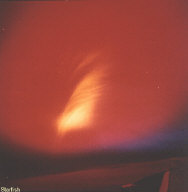
And from Honolulu, under some clouds:
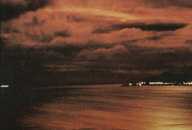
The Starfish Shot generated a radiation belt that killed or injured seven (or so) satellites in low orbit. It also caused some power spikes along some power lines in Hawaii, about 800 miles away.
Thirty strings of streetlights were knocked out from a voltage spike similar (but shorter and stronger) than those generated from CMEs. Lots of other power line breakers were tripped. Burglar alarms were set off. Some electronic equipment died, probably from transients on the power lines. There is anecdotal evidence of car ignitions fusing.
That same year, Russia detonated a 0.3 megaton nuclear explosion at about 180 miles altitude. It fused 350 miles of overhead telephone line, started a power plant fire and shut down 600 miles of buried power cables. I'm not sure whether the shutdown was because of the fire or the EMP. One difference between the Russian and Hawaiian damage is that Russia's power lines and phone lines run for hundreds of miles, but the largest island in Hawaii is less than 100 miles in diameter. The long lines in Russia (and Oklahoma) provide a better receptor for the EMP energy.
The Starfish shot was 1.6 megatons. The Sedan shot was exploded a few weeks later in Nevada 635 feet underground. It was 0.1 megatons. It made a small hole in the ground, 1/4 mile in diameter and 320 feet deep. You can find this on Google Earth or planet Earth at 37°10.37' N 116°2.46' W. The purpose of the Sedan shot was to test the use of nuclear explosions for earth moving applications. It moved around 12 million tons.
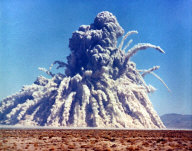

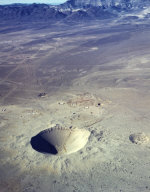
http://ndep.nv.gov/boff/photo02.htm
What about an EMP today, 44 years later? Modern electronics may be more vulnerable to EMP than older tube and large-transistor systems, but modern electrical equipment, phones, and consumer electronics are probably more resistant to voltage spikes. Power lines are supposed to have much better protection against transients today. I haven't tested any power lines to make sure, though. Today's satellites are more resistant to radiation than they were 40 years ago.
The damage from EMP is limited, for the most part, to line-of-sight distance from the explosion. It is more powerful at certain altitudes. I think if I had a fusion bomb and wanted to use it for major destruction, I'd use it near the surface. Missing cities are a lot more impressive than broken electronics.
Here's a detailed article on EMP:
http://glasstone.blogspot.com/2006/03/emp-radiation-from-nuclear-space.html
The Starfish shot wasn't just a shot in the dark. They launched some smaller warheads in 1958 to see if any "military significant effects" could be produced by high nuclear explosions. They could.
In May 1958, the U.S. exploded three "low yield" 1.7 kiloton missiles 100, 182, and 466 miles high. The USS Norton Sound launched the Argus X-17a missiles 1100 miles south of Africa.
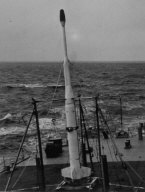
Here are details on the Argus tests:
http://nuclearweaponarchive.org/Usa/Tests/Argus.html
Here's the Norton Sound:

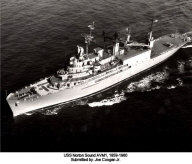
It started out life as a seaplane tender in late World War II.
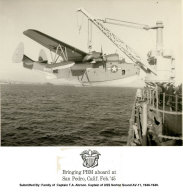
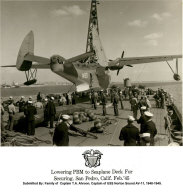
Here's a photo of a Captain Ben Scott Custer inspecting the Norton Sound shortly before the new ship left for battle in World War II.
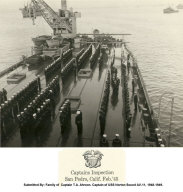
Captain Custer was known for running a tight ship. Here's a story told to Albert F. Becker Jr. by his father, one of Custer's crew:
Many former crewmen have already spoken of Captain Ben Scott Custer's
strictness and desire to run a tight, clean ship. It was clear he demanded that
all crewmen wear the proper uniform of the day at all times. But there were
times when some of the crewmen might have thought he could take his strictness
too far.
Sometime in June, 1945, so my father told me, the starboard watch was up for its normal weekly personnel inspection, meaning clean whites and spit shined shoes. As Custer strode up and down the neat rows of sailors on the hangar deck, the PA system suddenly erupted with the alarm for general quarters. The men started to break for their stations, only to be brought up short by Custer's voice, cracking like a whip across the deck. "Hold your positions!" he ordered. Amazed, the men peered at each other, but then reassembled to permit Custer to finish his inspection. Then--and only then--did he release the crew to their stations.
It seems an incredible story, but my father insisted it really happened. And I don't think Custer was crazy, either; only affirming to the men his devotion to Navy tradition. By God, no one--not even the Japanese--was going to interrupt one of his inspections!
Sometime in June, 1945, so my father told me, the starboard watch was up for its normal weekly personnel inspection, meaning clean whites and spit shined shoes. As Custer strode up and down the neat rows of sailors on the hangar deck, the PA system suddenly erupted with the alarm for general quarters. The men started to break for their stations, only to be brought up short by Custer's voice, cracking like a whip across the deck. "Hold your positions!" he ordered. Amazed, the men peered at each other, but then reassembled to permit Custer to finish his inspection. Then--and only then--did he release the crew to their stations.
It seems an incredible story, but my father insisted it really happened. And I don't think Custer was crazy, either; only affirming to the men his devotion to Navy tradition. By God, no one--not even the Japanese--was going to interrupt one of his inspections!
Custer left the Norton Sound in 1946. He went on to become a Rear Admiral, got a PhD in American History, and was president of Columbia University.

Here is some info on, stories about, and photos of the USS Norton Sound:
http://www.ussnortonsound.com/
Here are is some info and pretty pictures of nuclear explosions:
http://nuclearweaponarchive.org/Usa/Tests/
This was 3 megatons at 8000 feet, near Christmas Island in 1962.

This was 210 kilotons at 7000 feet, near Christmas Island in 1962.
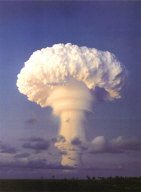
Here is an anti-submarine nuclear missile, less than 20 kilotons, 400 miles off San Diego in 1962. It was launched from the USS Agerholm.
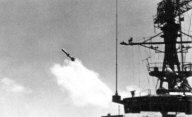

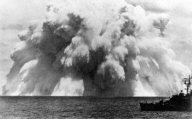
This photo was taken through the periscope of submarine USS Carbonero, thirty miles from the explosion near Christmas Island in 1962. The 600 kiloton Polaris A1 missile was launched about 1000 miles away, by the submarine USS Ethan Allen.
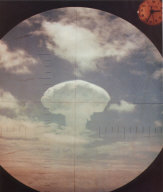
The US and USSR each exploded more than 100 nuclear weapons in 1961 and 1962. It was almost like they were preparing for war with each other.
Here's one going off from underwater:
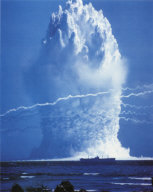
Atomic Bombs
Atomic bombs were popular back in the 1950s and 1960s. Then, amazingly, the term acquired a negative connotation. So they started calling them nuclear weapons. Atomic (or nuclear) fission and fusion would be a little more accurate, but then they'd have to come up with new words for fishin' and phishin'.All this thinking about uncontrolled nuclear fission reactions started when my baby sister Tricia called and suggested that we go on a bike ride. For 108 miles. Across White Sands Missile range. So we did!
It was a legal, organized ride, but we weren't allowed to take pictures or cameras. We started out at Tolarusa, rode up to within 12 miles of the Trinity Site where they exploded the first atomic nuclear fission phishin' bomb in 1945, ate lunch there, and looped back.
If you unzip this .gpx file and load it into Google Earth, you can see where we rode. Unless you have the latest beta version of Google Earth -- the .gpx input is broken in that one.
http://xpda.com/whitesands/whitesands.zip
Here's info on the Trinity Site and the first Bomb.
http://www.abomb1.org
Afterward, my knee hurt so I backed the car into a pole and smashed my sister's bicycle. This was also in retaliation of her baby daughter Claire backing a car over my bicycle wheel a few months ago.
White Sands is a desert area with very little water or vegetation. That explains this flood we found at White Sands National Monument.
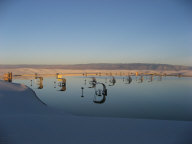
Last August they had 16 inches of rain, more than double the previous record for a month. It rained some more in September and October. Since White Sands has no drainage, they have to wait and let the floodwater evaporate. This should happen in a month or three. Here are some pictures from White Sands National Monument (mostly):
http://xpda.com/whitesands
Phishing is Popular
"Phishing" is fishing for usernames and passwords. To go fishing, sent out a few million emails redirecting people to fake web sites for banking, stock brokering, eBay, Paypal, or nuclear missile launch control. These fake sites should look like the originals, except they should log the usernames and passwords before redirecting to the intended site.Sound complicated? No problem. Just download a phishing kit for the low, low price of a credit card number. Then you can go to town. Or jail. But the rate of arrest and conviction of phishers is somewhere near zero percent, kind of like spammers. Why do they pass those laws and forget to enforce them, anyway?
http://news.zdnet.com/2100-1009_22-6126217.html
http://news.com.com/2100-1029_3-6125991.html
Vegemite
News Flash! Vegemite banned in the US -- all 11 customers outraged!http://www.news.com.au/story/0,23599,20623973-2,00.html
Saturn
Here's a good photo of Saturn blacklit by the sun, taken by Cassini.
It's a mosaic of 165 images taken over three hours on September 15. Ultraviolet, infrared, and visible (clear filter) light bands make up the red, green, and blue colors of this image. I'm not sure which bands correspond to which colors. The resulting colors were enhanced quite a bit.
http://photojournal.jpl.nasa.gov/catalog/PIA08329
Here's a good picture of Saturn's moon Janus, with Saturn in the background. It was taken September 25.
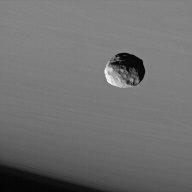
http://photojournal.jpl.nasa.gov/catalog/PIA08296
On the south pole of Saturn, Cassini found this rotating storm. It's about 5000 miles in diameter, with winds of about 350 mph.
Here's a 3-second movie of the storm taken over three hours on October 11 (3mb):
http://photojournal.jpl.nasa.gov/archive/PIA08332.mov
Details:
http://photojournal.jpl.nasa.gov/catalog/PIA08332
Think Snow!
The Beltsville Agricultural Research Center has a low temperature scanning electron microscope. That would be fun to have in the garage.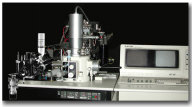
They've got some really cool (literally) snowflake photos.
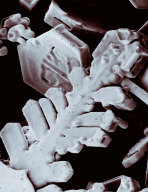

http://emu.arsusda.gov/snowsite/default.html
Luis Posada
Luis Posada was born 78 years ago in Cienfuegos, Cuba. He opposed the Castro revolution, and ended up in the U.S. in 1961. He got some training by the CIA in sabotage and explosives in preparation of the Bay of Pigs invasion, but he was not part of the failed effort.In the 1960s, Luis worked for the CIA in Miami. In 1968, Luis was accused of "gangster connections" and had a falling out with the CIA. Went to Venezuela and was the chief of operations of the Venezuelan intelligence service for a few years. After a falling out with the bosses in Venezuela, Luis left the intelligence service and started a private detective agency there.
Around 1976 Luis was probably involved in some hotel bombings in Havana.
Luis was arrested in Venezuela after the 1976 bombing of a Cuban DC-8 airliner. Two people who blew up the plane worked for Luis in his private detective agency. He escaped a year later and fled to Chile.
Chile apparently didn't like Luis because they sent him back to Venezuela where he was promptly sent back to jail. Eight years later Luis escaped again, dressed as a priest.
In 2000, Luis tried to blow up Castro at a summit meeting in Panama. He was arrested and spent a few years in a Panamanian jail. In 2005, he was released and came back to the U.S., requesting asylum.
The U.S. denied Luis asylum. His lawyers say he was trying to sneak out of the U.S. when he was arrested for "unlawful entry." He has been in Immigration jail in El Paso ever since. Cuba and Venezuela have requested Luis's extradition, but the U.S. refuses on the grounds of insufficient evidence and/or that he will be tortured. Venezuela does have an extradition treaty with the U.S.
Some people are accusing the U.S. of not prosecuting Luis as a terrorist because he used to work for the CIA against Cuba. Some other people say the U.S. should release Luis because the 78-year-old is not hurting anybody and is a friend of the country. Some others say Luis should be detained indefinitely without charge, as a terrorist.
To top all this off, many the FBI's records concerning Luis are missing, making it tough for the U.S. to file charges against Luis. They are trying to get copies from a Washington Post journalist.
It all seems really strange to me. Someday I'll have to take the time to figure all this out.
http://www.latinamericanstudies.org/posada.htm
http://www.washingtonpost.com/wp-dyn/con ... AR2006111001384.html
http://www.guardian.co.uk/cuba/story/0,,1930703,00.html
Chesapeake.com
Aspen Technology used to have a domain name called chesapeake.com. For almost 10 years, the city of Chesapeake, Virginia was asking them for the domain name. Finally, about a year ago, Aspen gave in and donated the name chesapeake.com to the city.Then, Chesapeake Energy (an Oklahoma company) offered the city of Chesapeake $120,000 for the domain name. They sold it, less than a year after Aspen Technology donated to them.
The funny part about story is that nobody is even using the domain! You just get an error when you go to http://chesapeake.com
http://content.hamptonroads.com/story.cfm?story=113271&ran=101133
Terrorists are Everywhere!
The Transportation Security Administration has a list of terrorists and terrorist sympathizers. I read that this list has about 200,000 names on it, but nobody's really saying for sure. But there have been 28,000 people go through the motions and submit several notarized copies of their identification to get removed from the list. The TSA isn't saying how many of them were successful.Here's a somewhat critical article of the situation. I think if I'd written it I would have been a bit more critical.
http://www.wired.com/news/technology/0,70783-0.html
747 Firefighter
Evergreen is coming out with a Boeing 747 modified as a fire fighting tanker. It will carry a whole mess of fire retardant. "Whole mess" is a technical aviation term equivalent to 24,000 gallons. That's seven times more than the P3, today's largest fire fighting aircraft.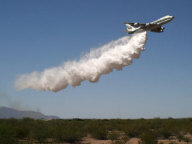
http://www.evergreenaviation.com/supertanker/faq.html
Hard Drive Encryption
A few days ago Seagate announced encrypted hard drives for laptop computers. The encryption software is in hard drive firmware.http://www.seagate.com/cda/newsinfo/news ... /0,1121,3347,00.html
I thought that sounded familiar. They also announced it in June 2005.
http://www.seagate.com/cda/newsinfo/newsroom/releases/article/0,,2732,00.html
I guess the new Drivetrust must be better.
Venus
This is a cool picture of Venus:http://antwrp.gsfc.nasa.gov/apod/ap061030.html
Alibris
Here's a convenient place to find old or unusual books and music. They apparently keep track of inventory in a bunch of bookstores and music stores. You order from Alibris and they drop ship from the stores. Amazon has a lot of these, but not all.http://www.alibris.com/search/search.cfm
Adopt a Microbe
Finally -- here's a blog I can read without getting bored!http://adoptamicrobe.blogspot.com
My sister says I don't think like other people. Weird, huh?
Nuclear Club
Six Arab countries announced plans to buy, borrow, or develop nuclear power plants. Algeria, Egypt, Morocco, Saudi Arabia, Tunisia, and the UAE. Nuclear power is good for generating electricity, desalinization of salt water, and making large explosions.http://www.timesonline.co.uk/article/0,,3-2436948,00.html
California may have to do some nuclear desalinization before too long if they keep salting their farmland. Now THAT's a scary thought -- a nuclear California.
Macro Photos
Here are some great close-up photos of insects. (It's a Russian site -- some of the ads might not be G-rated.)http://pishmo.com/macro
Wifi Speed Spray
Check this out! Speed up your wireless connection with Wifi Speed Spray. Art Linkletter's been using it successfully since 1948.http://j-walk.com/other/wifispray/
Raytheon UAV (or UAS)
Raytheon's Cobra Unmanned Aircraft System received and experimental airworthiness certificate last September. This includes the plane itself, the Cobra UAV, and a couple of control systems. They announced it a couple of weeks ago.The Cobra is 10 feet long with a 9-foot wingspan. It looks a little like an ordinary radio controlled model plane, although the wheels are pretty fancy.
http://xpda.com/junkmail/junk185/DSC02865.JPG
http://xpda.com/junkmail/junk185/DSC02888.JPG
But it performs a little differently than most RC models. It has a range of 20 miles and can stay up over three hours. With a max weight of over 100 lbs, it can carry 45 lbs of fuel and equipment. It even carries a 500-watt generator.
The Cobra's wide fuselage is designed to carry UAV test components, and is also shaped to provide a little additional lift.
I think I'd like one of these for Christmas.
http://xpda.com/junkmail/junk185/Cobra_UAS_Data_Sheet.pdf
http://www.raytheon.com/feature/cobra1106
Mission Accomplished
In May 1, 2003, President Bush flew to the aircraft carrier Abraham Lincoln in the copilot seat of a Navy S-3B Viking. I think that was fine. When I'm President I'll fly in all kinds of different planes. Then he gave a speech. In the background was a sign, "Mission Accomplished."http://www.cnn.com/2003/ALLPOLITICS/10/28/mission.accomplished/
The crew of the Abraham Lincoln did accomplish their mission, but the sign seemed to imply (as intended by the White House public relations people) that the war was over. Bush said in his speech " major combat operations in Iraq have ended," and "the tyrant has fallen, and Iraq is free."
People have been harassing Bush about this ever since.
You can see a video of his speech on the White House web site, near the bottom of this page:
http://www.whitehouse.gov/news/releases/2003/05
But you won't see the "Mission Accomplished" sign. They edited it out! They shifted the video up about 20%, removing the sign and leaving a big black bar across the bottom. I think that's cheating. It's also pretty dumb. They should have just stretched it upward so there wouldn't be a black bar on the bottom.
http://www.youtube.com/watch?v=-u2ITs4yIAE
Water Balloon
http://video.google.com/videoplay?docid=-8568478827662499191Alaska Dust Storm
Alaska enjoyed its second annual dust storm on the Copper River a couple of weeks ago.http://earthobservatory.nasa.gov/Newsroom/NewImages/images.php3?img_id=17452
Four years ago I flew down the Copper River in the Aircam. You can see how it could get a little dusty there from time to time.
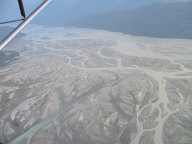
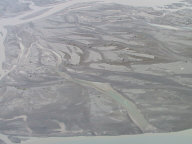

I really liked the repairs they made to this bridge.
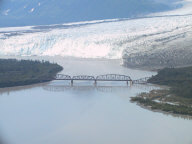
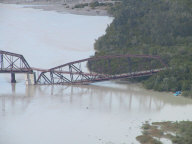
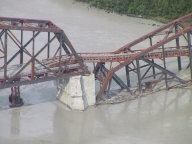
http://xpda.com/alaska02/
Today's Stupid Patent
Flickr has applied for a patent on "interestingness." It's how to decide whether a picture is interesting. It essentially ranks photos based on keywords and other metadata, traffic, time, etc. I my opinion that's not novel, original, or even noteworthy (except as a stupid patent).http://xpda.com/junkmail/junk185/interestingness.htm
"Media objects, such as images or soundtracks, may be ranked according to a new class of metrics known as "interestingness." These rankings may be based at least in part on the quantity of user-entered metadata concerning the media object, the number of users who have assigned metadata to the media object, access patterns related to the media object, and/or a lapse of time related to the media object."
1981
It seems like Aids has been around forever, but here's a 1981 headline from the BBC:1981: Mystery disease kills homosexuals
http://news.bbc.co.uk/onthisday/hi/dates ... _4020000/4020391.stm
Pictures of Today!
The Moon.http://xpda.com/junkmail/junk185/P1120536.JPG
http://xpda.com/junkmail/junk185/P1120537.JPG

A Colorado farm
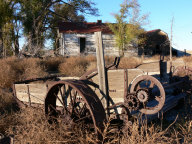
Sandhill cranes, flying south through Colorado about three weeks ago:

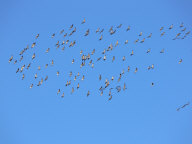
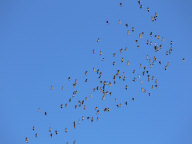
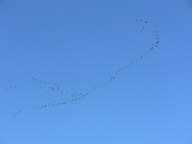
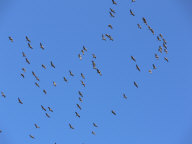

Some Kansas Sandhill Cranes
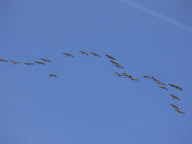
A Kansas Windmill
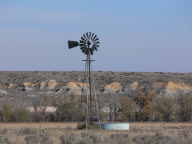
Monument Rocks, Kansas. These are south of Okley or Colby, I forgot which. They're pretty neat.
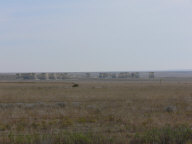
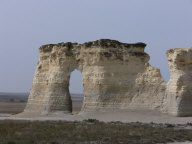
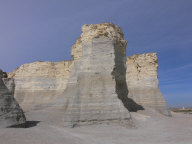
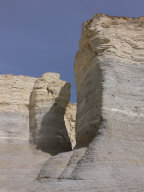
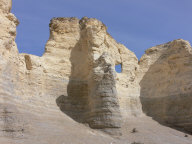
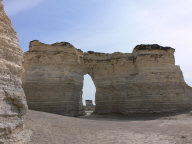
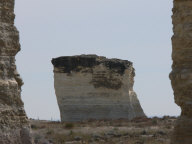
Mud Swallow Nests
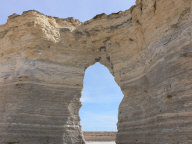
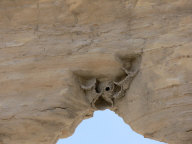
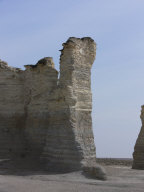

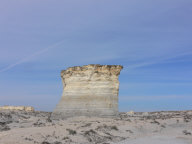
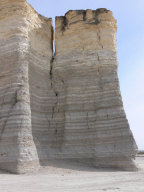

Big FAA Radar:
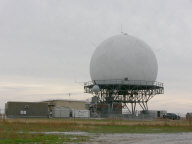
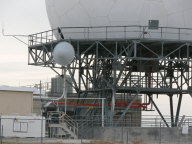
A Wild Horseman:
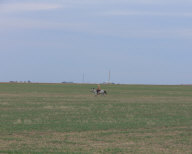
Texas Trees:
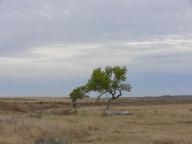
A Texas Windmill:
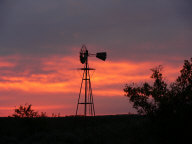
(-) 1938, no right reserved. Any unauthorized duplication, replication, distribution, or mastication of this fine piece of work, whether or not in accordance with digital rights mismanagement, is fine with me. Copy the heck out of it!
If you'd like to sign up for Junkmail, go to
http://xpda.com/junkmail
You can peruse and search the archives there, too. I changed over to Google search, so you might not be able to search every little word any more. But you can certainly read every word in all 185 Junkmails from 1998 to 2006, if you are so inclined and so warped.
If you'd like to stop getting this fine collection of pseudorandom zeros and ones, please select any or all of the following fun-filled options:
1. Use Boyan and RBBS instead of email.
2. Get an abacus and trash your computer.
3. Get a new email address and don't tell anybody what it is.
4. Send me an email with "Kangerlussuaq" as the subject.
I'm Bob Webster from Pryor, Oklahoma. You can usually run me down at bob@xpda.com
Have a good day!